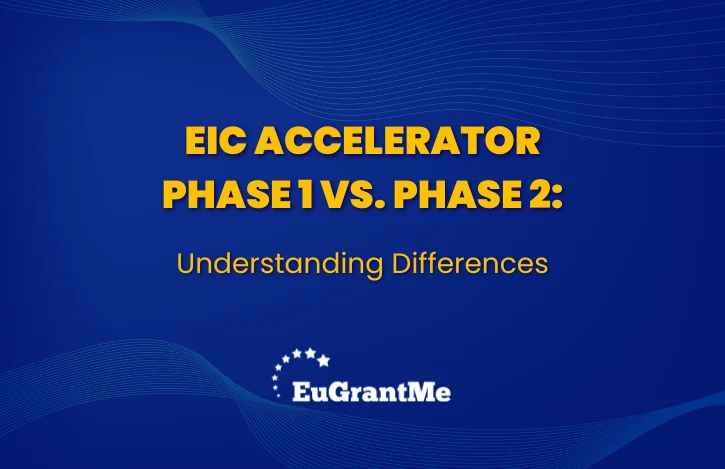Understanding the differences between EIC Accelerator phases is crucial for SMEs seeking funding. The EIC Accelerator supports innovative projects, helping businesses develop and scale their solutions. Knowing how EIC Phase 1 and Phase 2 differ can significantly impact your project strategy. This article will explore these differences, providing clarity on what to expect in each phase.
Overview of the EIC Accelerator
The EIC Accelerator is designed to support small and medium-sized enterprises with innovative projects. It aims to provide funding and resources to help businesses bring their ideas to market. The programme is divided into two phases: Phase 1 focuses on feasibility assessments, while Phase 2 centres on scaling innovations.
Understanding the structure of these phases is essential for navigating the application process. Each phase serves distinct purposes, which can shape your project’s development.
EIC Accelerator Phase 1: Feasibility Assessment
Phase 1 of the EIC Accelerator is primarily concerned with feasibility assessments. During this phase, SMEs receive funding to conduct in-depth analyses of their project ideas. This includes market research, technical assessments, and risk evaluations.
The goal of Phase 1 is to help businesses determine whether their innovation is viable. Successful applicants can receive a grant of up to €75,000 for a duration of around 6 months. This funding is crucial for validating the concept and ensuring that the project is worth pursuing further.
EIC Accelerator Phase 2: Scale-up and Commercialisation
In contrast, Phase 2 focuses on the scale-up and commercialisation of the innovation. This phase is for SMEs that have validated their concepts in Phase 1 and are ready to take the next step. Funding in Phase 2 can reach up to €2.5 million, enabling businesses to accelerate their development processes.
This funding supports various activities, including product development, testing, and market entry strategies. Moreover, the duration of Phase 2 projects typically ranges from 12 to 24 months, providing ample time for implementation.
Key Differences in Funding
The funding amounts and purposes differ significantly between the two phases. In Phase 1, the grant is smaller and focused on feasibility studies. The funding helps businesses assess whether their ideas are practical and marketable.
Conversely, Phase 2 offers substantial funding aimed at actual project execution. The increased financial support reflects the higher risks and rewards associated with scaling an innovation. Understanding these funding differences is essential for SMEs as they plan their applications.
Application Process and Requirements
The application processes for the two phases also vary. Phase 1 applications require a simpler submission focused on the feasibility of the project. Applicants must demonstrate a clear understanding of their market and potential obstacles.
Phase 2 applications, however, demand a more comprehensive approach. Businesses must provide detailed plans on how they intend to scale their innovation. This includes a robust business plan, technical development strategies, and a clear market entry plan. Therefore, preparing for each phase’s requirements is crucial for success.
Support and Guidance
Both phases offer different levels of support and guidance for applicants. In Phase 1, the focus is on helping businesses identify potential challenges and assess their project’s viability. Applicants may receive advice on conducting feasibility studies and improving their proposals.
In Phase 2, support extends beyond assessment. Businesses may benefit from mentoring, networking opportunities, and access to various resources. This additional support can help SMEs navigate the complexities of scaling their innovations.
Focus on Market Impact
The emphasis on market impact varies between the two phases. Phase 1 is primarily concerned with determining feasibility. Consequently, the focus is on understanding market needs and validating the concept.
On the other hand, Phase 2 prioritises actual market entry and scaling. Here, the goal is to ensure that the innovation reaches its intended audience. This focus on market impact requires businesses to develop effective marketing and sales strategies.
Risk Management Considerations
Risk management is a crucial aspect of both phases, but the emphasis differs. In Phase 1, businesses need to identify potential risks associated with their project. This could include technical feasibility, market demand, and financial considerations.
In Phase 2, the focus shifts to managing risks during the scaling process. SMEs must develop strategies to address challenges that may arise while entering the market. This proactive approach to risk management is vital for ensuring project success.
Collaboration and Networking Opportunities
Collaboration plays an important role in both phases, although it takes different forms. In Phase 1, applicants may engage with potential partners to validate their ideas. This collaboration can help gather insights and feedback that improve project feasibility.
Phase 2 provides more extensive networking opportunities. Successful applicants gain access to a network of investors, mentors, and industry experts. These connections can be invaluable for navigating the challenges of scaling a business and expanding into new markets.
Understanding the differences between EIC Accelerator phases is essential for SMEs aiming for success. Each phase offers unique funding opportunities, requirements, and support structures. By recognising these distinctions, businesses can tailor their approaches and enhance their applications. With clear goals and strategies for each phase, you can significantly improve your chances of receiving EIC Accelerator funding. Therefore, as you prepare for your journey, focus on the specific requirements of each phase to maximise your project’s potential.
At EuGrantMe, we are passionate about fostering innovation and empowering ambitious minds to flourish. Our mission revolves around providing top-notch grant writing services for the EIC Accelerator and Horizon grants in Europe. We enable our customers to unlock the full potential of their ground-breaking ideas.
Do you have a project to turn into reality?
Contact us!


